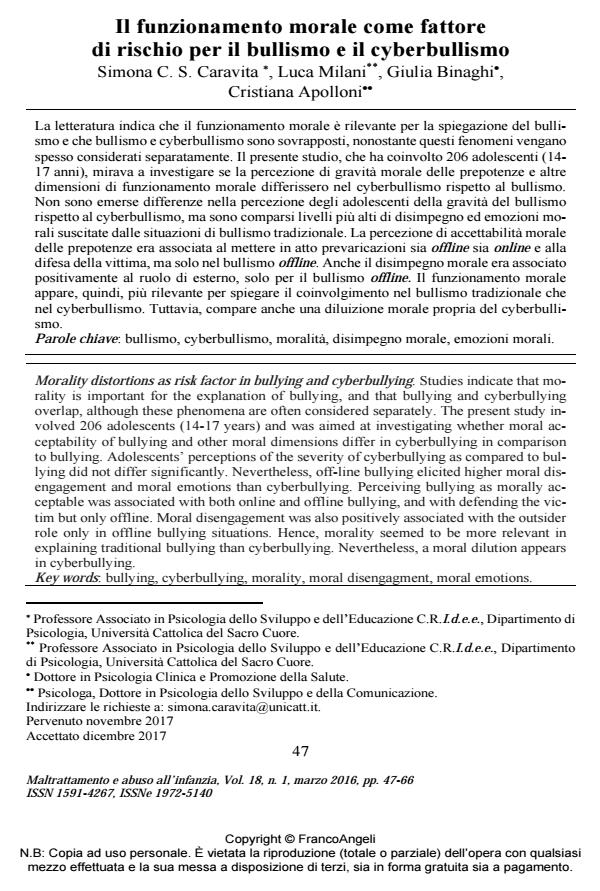Il funzionamento morale come fattore di rischio per il bullismo e il cyberbullismo
Titolo Rivista MALTRATTAMENTO E ABUSO ALL’INFANZIA
Autori/Curatori Simona C. S. Caravita, Luca Milani, Giulia Binaghi, Cristiana Apolloni
Anno di pubblicazione 2018 Fascicolo 2018/1
Lingua Italiano Numero pagine 20 P. 47-66 Dimensione file 262 KB
DOI 10.3280/MAL2018-001004
Il DOI è il codice a barre della proprietà intellettuale: per saperne di più
clicca qui
Qui sotto puoi vedere in anteprima la prima pagina di questo articolo.
Se questo articolo ti interessa, lo puoi acquistare (e scaricare in formato pdf) seguendo le facili indicazioni per acquistare il download credit. Acquista Download Credits per scaricare questo Articolo in formato PDF

FrancoAngeli è membro della Publishers International Linking Association, Inc (PILA)associazione indipendente e non profit per facilitare (attraverso i servizi tecnologici implementati da CrossRef.org) l’accesso degli studiosi ai contenuti digitali nelle pubblicazioni professionali e scientifiche
La letteratura indica che il funzionamento morale è rilevante per la spiegazione del bullismo e che bullismo e cyberbullismo sono sovrapposti, nonostante questi fenomeni vengano spesso considerati separatamente. Il presente studio, che ha coinvolto 206 adolescenti (14-17 anni), mirava a investigare se la percezione di gravità morale delle prepotenze e altre dimensioni di funzionamento morale differissero nel cyberbullismo rispetto al bullismo. Non sono emerse differenze nella percezione degli adolescenti della gravità del bullismo rispetto al cyberbullismo, ma sono comparsi livelli più alti di disimpegno ed emozioni morali suscitate dalle situazioni di bullismo tradizionale. La percezione di accettabilità morale delle prepotenze era associata al mettere in atto prevaricazioni sia offline sia online e alla difesa della vittima, ma solo nel bullismo offline. Anche il disimpegno morale era associato positivamente al ruolo di esterno, solo per il bullismo offline. Il funzionamento morale appare, quindi, più rilevante per spiegare il coinvolgimento nel bullismo tradizionale che nel cyberbullismo. Tuttavia, compare anche una diluizione morale propria del cyberbullismo.
Parole chiave:Bullismo, cyberbullismo, moralità, disimpegno morale, emozioni morali
- Focus Monotematico: Il Cyberbullismo come emergenza sociale: indicazioni per l'intervento alla luce della nuova normativa Maria Assunta Zanetti, Simona C. S. Caravita, in MALTRATTAMENTO E ABUSO ALL'INFANZIA 1/2018 pp.7
DOI: 10.3280/MAL2018-001001
Simona C. S. Caravita, Luca Milani, Giulia Binaghi, Cristiana Apolloni, Il funzionamento morale come fattore di rischio per il bullismo e il cyberbullismo in "MALTRATTAMENTO E ABUSO ALL’INFANZIA" 1/2018, pp 47-66, DOI: 10.3280/MAL2018-001004